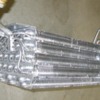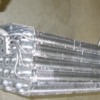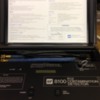quote:
Originally posted by LF - TP 2511:
the R-12 substitutes such as Hot Shot, Freeze 12, etc.
Kelly,
One big issue with using the substitutes is any shop still doing R-12 service will likely sniff your system prior to working on it. If they find the substitutes they will not work on your system. That is because the substitutes may clog their machine or contaminate their recovery tank.
Of course, if the system is accidentally vented to the atmosphere prior to a visit to the shop, there isn't that problem.
The fine for "Accidentally venting" refrigerant to the atmosphere is $50,000.00 for a individual and $1,000,000.00 for a company or business for every instance.
If i found anyone deliberately dumping refrigerant i would report them immediately.
Would you think it was ok to smash up your kids school ? Then why smash up your kids world ?
There is no way available to the average A/C shop for them to tell what gas is in your system. They rely on assumptions based on the age of the system, the types of fittings used, what was known to be used in that type of car, labels on the system itself and word of mouth of the owner.
Any of those assumptions may be wrong, especially in a old car where its A/C history is unknown or vague.
Any one could have put anything in it at any stage.
Shops know this and they are fully able to cope with it.
Any BS they might tell you about unknown refrigerants clogging up their gear is just that, "BS".
It would be just used as an excuse to charge you twice as much (or more). If they tell you they cant handle unknown refrigerants then go some where else.
It is another attempt to keep Air Conditioning/Refrigeration in the realm of a "black art" only to be practiced by "voodoo witch doctors" and the average car owner must pay the high priests a large sum to get their old system worked on, updated, repaired because of all kinds of mythical problems beyond reasonable comprehension.
One of the many old time scams of the car A/C mechanic was to tell owners that the "gas breaks down and goes bad" after a while and you need a yearly recharge.
This is total shibe.
One of the major problems with Dichloro-Diflouro-Methane (R-12) was that it was one of the most stable chemicals ever created by man and thus persisted in the enviroment indefinately causing all kinds of problems. (Ozone depletion)
It didn't break down at all, so why did Mr car A/C mechanic tell you it did ? To play on your ignorance and screw you for more money needlessly.
If you want to play around with your A/C system and do repairs, mods, updates ect, buy a recovery unit.
It will make your life much more pleasant. You will be able to pump out your system, save the gas, work on it, fix leaks, vacuum pump it, recharge it and all at your own leisure, no rush trips to the A/C shop and you'll only need to do that a few of times and it will pay for it self. I've had to pump my system out and recharge it a few times in a day in the effort to seek out a elusive slow leak (the hardest to find) that would have cost me a bundle if i had to do it through a shop.
Shops won't fix slow leaks (leaks that take 2,3 or more months) because they are notoriously hard to find, they often don't leak oil with the gas so there is no tell tail trace to follow.
Hoses often leak refrigerant through the walls of the hose (very very slowly) so there is no trace, but when you go to use your A/C after a 4 or 5 month break it's not cold, the refrigerant has leaked away.
I like to use stainless steel tube for refrigerant lines rather than hoses, especially the compressor discharge line (it gets very hot, bad for any kind of rubber) and the liquid lines. If extra flexibility is needed coil the stainless tube up like a spring, it will act just like that, absorbing any vibration, movement or twisting.
Another source of slow leakage was the sump and head gaskets on the old York compressors. The gaskets cold be sealing perfectly, no oil leaks, but the refrigerant would escape. How ? It would leak through the gasket material itself, not around it but through it !
My advise for compressors is replace the York with the Sanden SD7H15. This is around the same capacity as the York but is a much better compressor capable of much higher speeds. SD508 compressors are a bit small (8 cubic inches).
York's are 9.5 or 10.5 cubic inches. SD7H15 are about 10 cubic inches. Drive the SD7H15 faster than the York was driven.
There is no such thing as a R-12 or R-135a compressor. They are mechanically exactly the same. The only differences may be different types of oil may be inside them and different compound o-rings and seals may be used. But i have used R-12 compressors with R-134a with no problems. Compressors don't care what gas is going through them, i've used a Sanden SD508 as a air compressor !
Does R-134a work in a old R-12 system ? Yes, but it is not as efficient in that system.
How do i modify my old R-12 system to get the best efficiency from R-134a ?
To cut the BS you need more condenser capacity to be able to dump more heat and produce more liquid (refrigerant), you need more liquid storage capacity (larger filter dryer) and more evaporator capacity (larger evaporator) to enable a larger volume of liquid to boil off thus cooling your cars interior. That's why the SD7H15 must run faster than the York,it needs to physically move more R-134a than the York had to move R-12.
You will also need a new thermal expansion valve (TXV) to suit R-134a.
A note on receiver/dryers. Anytime you work on a system they need to be replaced !!!
The most important thing about them is the desiccant they contain. It is there to trap water (vapor/humidity) that gets into the system when it is open to atmosphere (eg: when you are fixing a leak or replacing a component). Water will kill your A/c stone dead !
It doesn't take all that much moisture to overwhelm the desiccant and once that happens water and refrigerant and refrigerant oil are a very bad mix.













